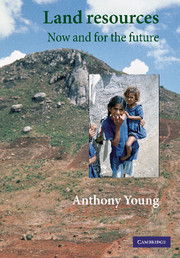Book contents
- Frontmatter
- Contents
- Preface
- Acknowledgements
- Note on acronyms and currency
- 1 Concern for land
- 2 Land resource issues
- 3 Resource survey and land evaluation
- 4 Competition for land
- 5 Working with farmers
- 6 Land use planning
- 7 Land degradation
- 8 Global issues: climatic change and biodiversity
- 9 Monitoring change: land resource indicators
- 10 Costing the earth: the economic value of land resources
- 11 Land management: caring for resources
- 12 Research and technology
- 13 Land, food, and people
- 14 Population, poverty, and conflict
- 15 Awareness, attitudes, and action
- Notes
- References
- Index
15 - Awareness, attitudes, and action
Published online by Cambridge University Press: 04 August 2010
- Frontmatter
- Contents
- Preface
- Acknowledgements
- Note on acronyms and currency
- 1 Concern for land
- 2 Land resource issues
- 3 Resource survey and land evaluation
- 4 Competition for land
- 5 Working with farmers
- 6 Land use planning
- 7 Land degradation
- 8 Global issues: climatic change and biodiversity
- 9 Monitoring change: land resource indicators
- 10 Costing the earth: the economic value of land resources
- 11 Land management: caring for resources
- 12 Research and technology
- 13 Land, food, and people
- 14 Population, poverty, and conflict
- 15 Awareness, attitudes, and action
- Notes
- References
- Index
Summary
Improvements in land resource management can only come about if they are preceded by awareness of the problems, and recognition of the need for action. At international level, there is a strong measure of agreement on priorities, including poverty reduction, avoidance of land degradation, research, and people's participation in decision-making. At national level, land resource policies cannot be applied in isolation. There first needs to be avoidance of civil conflict, good government, and attention to development of the rural sector, leading to a recognition of the role of land resources. This provides a framework for a set of national land resource policies, including improved survey and evaluation, efforts to combat land degradation, the effective linking of research with extension, a national land use plan, and monitoring of the national heritage of land resources. This will require a strengthening of institutions, with improvements in education and training. None of these measures will be fully effective unless accompanied by greater efforts to reduce rates of population growth; demographic policy is an integral part of rural land development.
Land resources play a critical role in human welfare. Land is no longer abundant, and its productive potential is being reduced by degradation. Sustainability, the combination of production with conservation of resources to meet the needs of future generations, is the key to land management. Whilst a valuable contribution can come from international co-operation, the ultimate responsibility lies with the people and governments of developing countries. Awareness, and with it the will to bring about change, can only come from within.
- Type
- Chapter
- Information
- Land ResourcesNow and for the Future, pp. 273 - 289Publisher: Cambridge University PressPrint publication year: 1998



